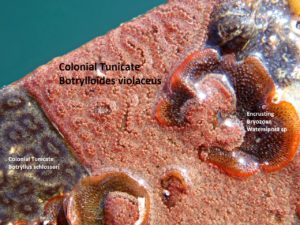by Kristen Minogue

SERC marine biologist Brianna Tracy holds a plate with marine life pulled from a dock in San Francisco. (Photo: Kristen Minogue/SERC)
Strange things grow on the bottoms of docks: brightly colored sponges, mat-like tunicates, and wispy, flower-shaped anemones. Many of these mysterious life forms are invasive species. This spring, Smithsonian marine biologists launched Invader ID, an online citizen science project calling on anyone with an Internet connection to help detect them.
The project centers on San Francisco Bay. With over 200 non-native species, it’s the most invaded estuary in North America. “The majority of the species that we identify in the San Francisco Bay are invasive,” said Brianna Tracy, a biologist with the Smithsonian Environmental Research Center.

A plate pulled from a survey in California, with two nonnative tunicates (Botryllus schlosseri and Botrylloides violaceus) and a bryozoan. (Photo: Brianna Tracy)
Tracy works with the center’s Marine Invasions Lab, which has been studying San Francisco Bay for nearly 20 years. To keep tabs on the Bay’s underwater life, the team hangs plastic tiles from docks. Three months later, they pull the tiles from the water and identify all the colorful marine organisms growing on them. These surveys help scientists pinpoint where invasive species are thriving, and spot new invaders before they begin causing problems. And by Tracy’s count, the invaders are dominating. “Almost everything we see on a plate is nonnative….We get maybe one native species per panel sometimes.”
Over the years, the team has collected thousands of tiles. But with little more than a skeleton crew able to examine them, they’re experiencing some serious bottlenecks.
That’s where citizen science comes in. The biologists have photographed every tile they’ve collected. This spring they uploaded nearly 8,000 photos of 160 tiles on the Invader ID Website, launched March 21 on the citizen science platform Zooniverse. Each photo asks citizen scientists to identify a different organism on a tile, so there can be up to 50 photos of the same tile. They can select which group an organism belongs to, like sponges, barnacles, algae, anemones or mollusks. If a viewer is stumped, Invader ID also offers a few simple questions to help. (Hard or soft? Patterned or one color? Long and skinny, or short and stubby?)
Right now, Invader ID has just a small fraction of the roughly 10,000 tiles in their entire database. If the first phase succeeds, the biologists hope to expand Invader ID to include tiles from Alaska as well as San Francisco Bay. “There’s very few people who do this work. So with a project like this, we can really expand our scope,” Tracy said.
If the team could one day use Invader ID for all 20,000 tiles, it would translate to over 1 million photos for citizen scientists to pore over. The ultimate “dream big goal,” Tracy added, would be for people to be able to hang tiles from their own docks for three months, snap a photo of what grows there and upload their pics to the site. But for now, she hopes Invader ID gives people a glimpse of the hidden life beneath the surface. “What they’re scraping off their boats and what’s growing underneath the dock is more than just mud and oysters and algae.”
Want to join the project? Visit Invader ID at https://www.zooniverse.org/projects/serc/invader-id.

